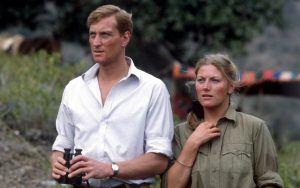Anne de Courcy in The Telegraph:
 Paul Scott, author of The Jewel in the Crown (1966), said of India: “It was mysteriously in our blood and perhaps still is.” Despite the comparatively small number of British who actually went there – in 1901, at the height of the Raj, there were only about 155,000 in the subcontinent – there was an extraordinary bond. Some families didn’t come home for centuries, but stayed in India “generation after generation, as dolphins follow in line across the open sea,” as Kipling put it. David Gilmour, author of Curzon (1994) and The Ruling Caste (2005), has tackled this rich history in The British in India, from the granting of the East India Company’s charter in 1600 to the mid-1960s, when the hippy invasion began. Although the chronology is never in doubt, his treatment is grouped by topic – intimacies, formalities, voyages, working life, and so on. The result is somewhat like a tapestry.
Paul Scott, author of The Jewel in the Crown (1966), said of India: “It was mysteriously in our blood and perhaps still is.” Despite the comparatively small number of British who actually went there – in 1901, at the height of the Raj, there were only about 155,000 in the subcontinent – there was an extraordinary bond. Some families didn’t come home for centuries, but stayed in India “generation after generation, as dolphins follow in line across the open sea,” as Kipling put it. David Gilmour, author of Curzon (1994) and The Ruling Caste (2005), has tackled this rich history in The British in India, from the granting of the East India Company’s charter in 1600 to the mid-1960s, when the hippy invasion began. Although the chronology is never in doubt, his treatment is grouped by topic – intimacies, formalities, voyages, working life, and so on. The result is somewhat like a tapestry.
He makes it plain that his subject is not the morality of ruling great swathes of land that belonged to others. “I am not going to attempt… to produce a balance sheet, to weigh indigo planters who tyrannised Indian peasants against doctors who saved Indian lives, or to balance the undoubted violence of British soldiers against the deeds of a famine worker or a builder of canals.” Instead, he gives us just about everything one has ever heard of, or would wish to know, about the British in India, from what these expatriates ate – anglicised curries and kedgeree, with chicken as a backstop – to their painful separation from their children, who were sent “home” to school at the age of five. Superbly researched, The British in India is authoritative and comprehensive.
More here.
